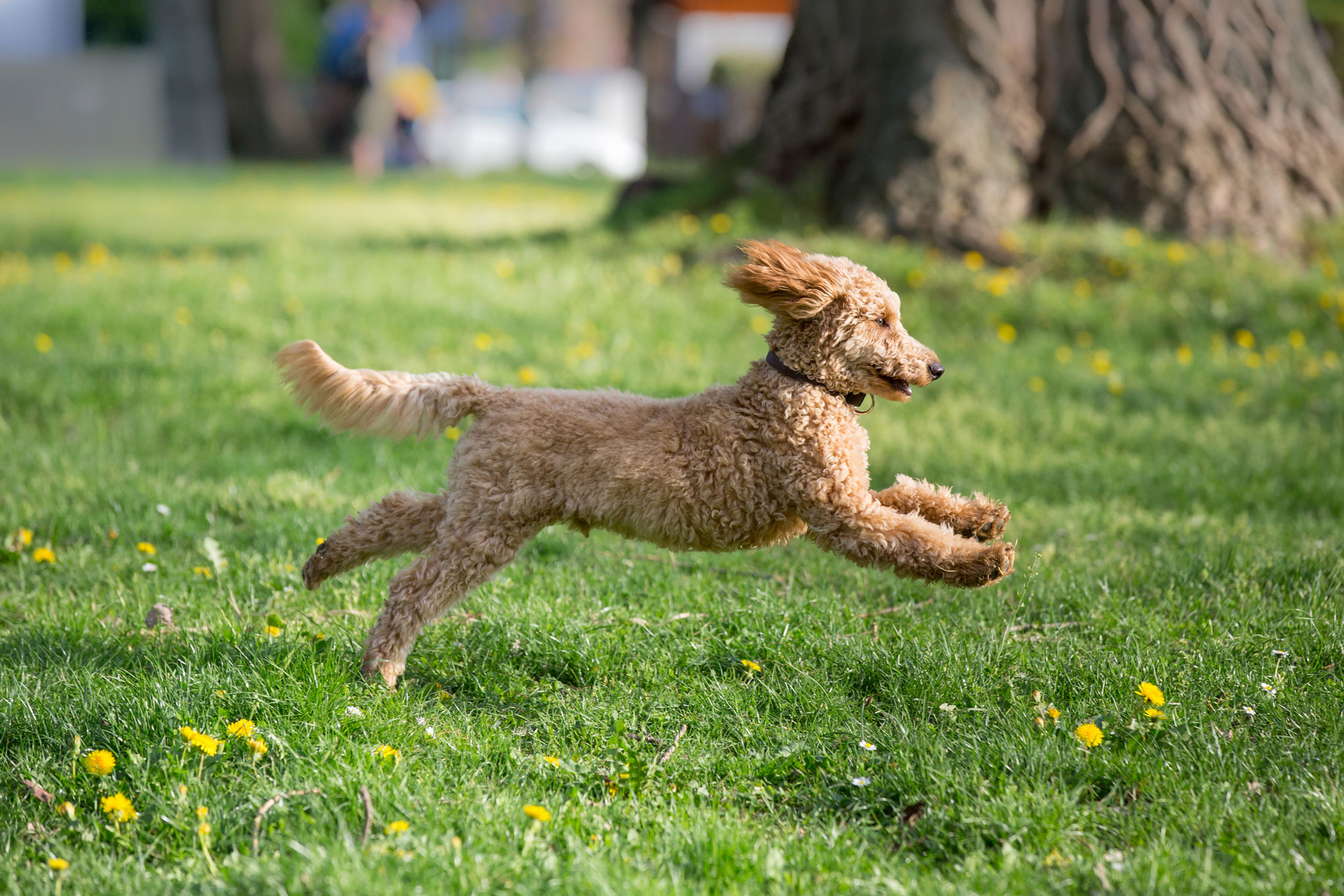Health Testing

At Country Lane Doodles, we want to produce the healthiest puppies possible and therefore, we complete health testing on our parent dogs.
Learn About Health Testing
Select the category of interest.
ORTHAPEDIC FOUNDATION FOR ANIMALS (OFA)
| Hips | The hip of the dog is a ball and socket type joint. These two joints are held into position with ligaments that attach the ball to the socket. Inside this joint there is a layer of spongy cartilage that helps to cushion the joint. When these two joints separate hip dysplasia can be evident. Hip dysplasia can cause limping and an uneven gate. Dogs that are affected may look as though they have arthritis – being stiffer in the morning or after exercise. |
| Elbows | The elbows are also x-rayed much like the hips, for very similar reasons. The grading system is slightly different than with the hips in that it is either passing or failing. A passing grade will be considered “Normal”. In this case only the non passing x-rays will be graded according to the severity of the problem. |
| Cardiac | This means that they have been examined by a Veterinary Cardiologist who has had training specific to canine cardiology or that they have been given OFA cardiac clearance by our vet. They listen for symptoms of sub aortic stenosis or hereditary heart murmurs. If something is noted the dog will then be sent for an echo cardiogram to determine the status of the dog. If the veterinarian found no problems with the dog they will be issued a “Normal” status. |
CANINE EYE REGISTRATION FOUNDATION (CERF/CAER)
| Eyes | Exam to screen for canine eye diseases including Keratoconjunctivitis, Sicca (dry eye), Glaucoma and Cataracts. |
GENETIC TESTING

| Degenerative Myelopathy | An inherited neurologic disorder caused by a Mutation of the SOD1 gene. This mutation is found in many breeds of dog, though it is not clear for some breeds whether all dogs carrying two copies of the mutation will develop the disease. The variable presentation between breeds suggests that there are environmental or other genetic factors responsible for modifying disease expression. The average age of onset for dogs with degenerative myelopathy is approximately nine years of age. The disease affects the White Matter tissue of the spinal cord and is considered the canine equivalent to amyotrophic lateral sclerosis (Lou Gehrig’s disease) found in humans. Affected dogs usually present in adulthood with gradual muscle Atrophy and loss of coordination typically beginning in the hind limbs due to degeneration of the nerves. The condition is not typically painful for the dog, but will progress until the dog is no longer able to walk. The gait of dogs affected with degenerative myelopathy can be difficult to distinguish from the gait of dogs with hip dysplasia, arthritis of other joints of the hind limbs, or intervertebral disc disease. Late in the progression of disease, dogs may lose fecal and urinary continence and the forelimbs may be affected. Affected dogs may fully lose the ability to walk 6 months to 2 years after the onset of symptoms. Affected medium to large breed dogs can be difficult to manage and owners often elect euthanasia when their dog can no longer support weight in the hind limbs. |
| Ichthyosis (Golden Retriever Type) | An inherited condition of the skin affecting dogs. The age of onset and severity of disease are highly variable, however most affected dogs present before one year of age with flaky skin and dull hair. Over time the skin develops a grayish color and appears thick and scaly, especially over the abdomen. The symptoms may progress to severe scaling all over the body, may improve with age, or may come and go over the dog’s lifetime. While the prognosis is generally good for affected dogs, they are at increased risk for skin infections. |
| Neonatal Encephalopathy with Seizures | An inherited neurologic disease known to affect dogs. Affected puppies are smaller than littermates at birth, have difficulty nursing after a few days of life, and often die by 1 week of age. By 3 weeks of age, surviving puppies present with neurologic symptoms including muscle weakness, tremors, inability to walk, wide-based stance and frequent falling. The disease quickly progresses to severe seizures that become non-responsive to treatment. Affected dogs typically die or are euthanized by 7 weeks of age. |
| Progressive Retinal Atrophy, golden Retriever 1 (GR-PRA1) | A late-onset inherited eye disease affecting dogs. Affected dogs begin showing clinical symptoms related to retinal degeneration between 6 to 7 years of age on average, though age of onset can vary. Initial clinical signs of progressive retinal atrophy involve changes in reflectivity and appearance of a structure behind the Retina called the Tapetum that can be observed on a veterinary eye exam. Progression of the disease leads to thinning of the retinal blood vessels, signifying decreased blood flow to the retina. Affected dogs initially have vision loss in dim light (night blindness) and loss of peripheral vision, eventually progressing to complete blindness in most affected dogs. |
| Progressive Retinal Atrophy, Golden Retriever 2 (GR-PRA2) | A late-onset inherited eye disease affecting dogs. Affected dogs begin showing clinical symptoms related to retinal degeneration at around 4 to 5 years of age on average, though age of onset can vary. Initial clinical signs of progressive retinal atrophy involve changes in reflectivity and appearance of a structure behind the Retina called the Tapetum that can be observed on a veterinary eye exam. Progression of the disease leads to thinning of the retinal blood vessels, signifying decreased blood flow to the retina. Affected dogs initially have vision loss in dim light (night blindness) and loss of peripheral vision, progressing to complete blindness in most affected dogs. |
| Progressive Retinal Atrophy, progressive Rod-Cone Degeneration (PRA-prcd) | A late onset, inherited eye disease affecting Goldendoodles. PRA-prcd occurs as a result of degeneration of both rod and cone type Photoreceptor Cells of the Retina, which are important for vision in dim and bright light, respectively. Evidence of retinal disease in affected dogs can first be seen on an Electroretinogram around 1.5 years of age for most breeds, but most affected dogs will not show signs of vision loss until 3 to 5 years of age or later. The rod type cells are affected first and affected dogs will initially have vision deficits in dim light (night blindness) and loss of peripheral vision. Over time affected dogs continue to lose night vision and begin to show visual deficits in bright light. Other signs of progressive retinal atrophy involve changes in reflectivity and appearance of a structure behind the retina called the Tapetum that can be observed on a veterinary eye exam. Although there is individual and breed variation in the age of onset and the rate of disease progression, the disease eventually progresses to complete blindness in most dogs. Other inherited disorders of the eye can appear similar to PRA-prcd. Genetic testing may help clarify if a dog is affected with PRA-prcd or another inherited condition of the eye. |
| Von Willebrand Disease I (VWD) | an inherited bleeding disorder affecting Goldendoodles. Dogs affected with VWDI have less than half of the normal level of von Willebrand coagulation factor (vWf), which is an essential protein needed for normal blood clotting. There is variability in the amount of vWf made such that not all dogs with two copies of the Mutation are equally affected. Dogs that have less than 35% of the normal amount of vWf generally have mild to moderate signs of a bleeding disorder. Affected dogs may bruise easily, have frequent nosebleeds, bleed from the mouth when juvenile teeth are lost, and experience prolonged bleeding after surgery, trauma, or estrus. Dogs may show signs of lameness or stiffness if bleeding occurs in the joints or muscle. Less often, the bleeding may be severe enough to cause death. Due to the variable severity of the disorder, affected dogs may not be identified until a surgery is performed or trauma occurs at which time excessive bleeding is noted. Veterinarians performing surgery on known affected dogs should have ready access to blood banked for transfusions. Most dogs will have a normal lifespan with this condition despite increased blood clotting times. |
For more information, contact us.

